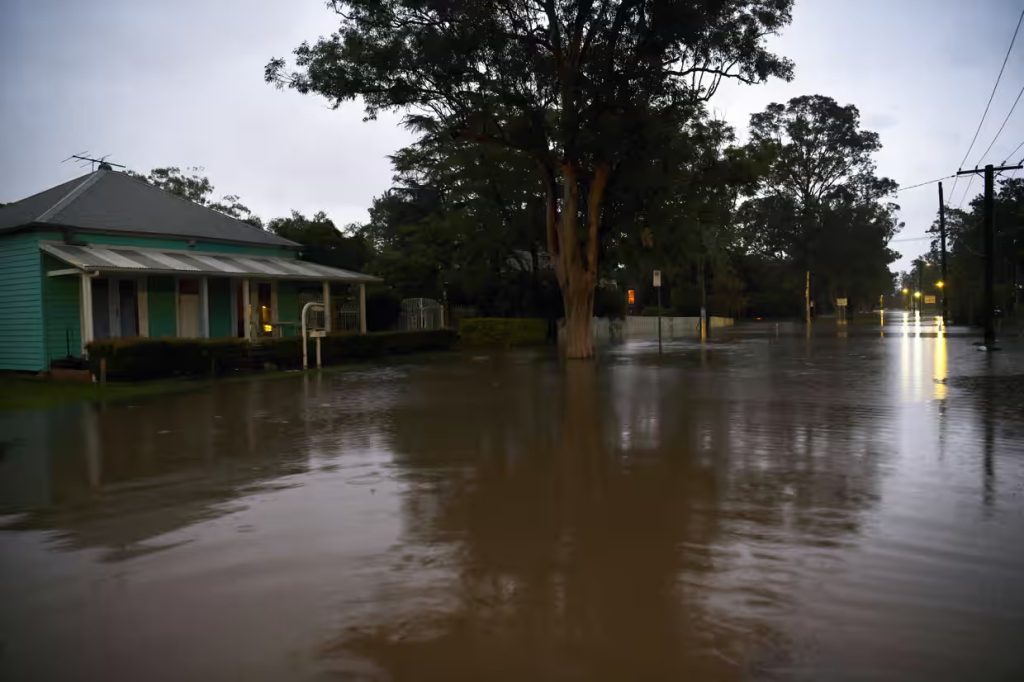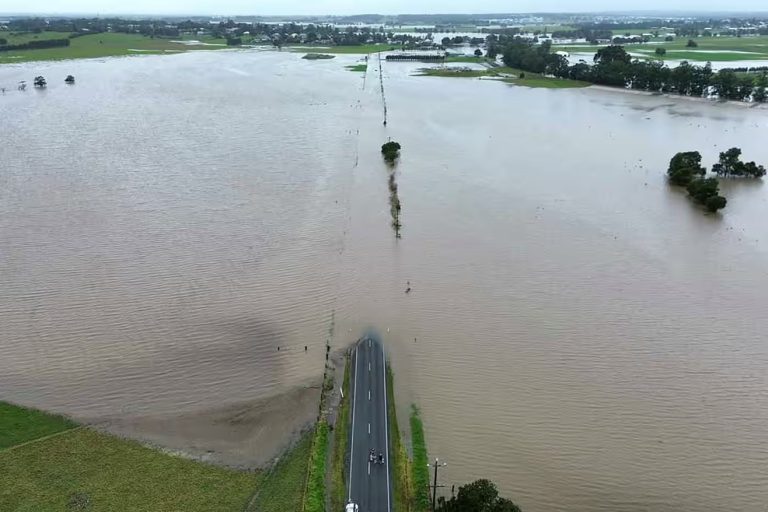Record-breaking floods on the mid-north coast of New South Wales have left over 48,800 people and 23,200 homes cut off, the State Emergency Service (SES) confirmed on Wednesday. With more rain on the way—up to 200mm expected in the next 24 to 48 hours—authorities remain on high alert.
Communities along the Manning River, including Taree, Wingham, and Glenthorne, are facing the worst flooding in living memory, with the river exceeding its historic 1929 peak. Homes and businesses have been submerged, and many residents spent anxious hours awaiting rescue.
The SES carried out 284 rescues in just 24 hours, focusing on those in the most dangerous situations. Nine helicopters were deployed on Wednesday to assist in evacuations, particularly people trapped on rooftops or in rising floodwaters, according to Premier Chris Minns.
Among those rescued was Jordan Halloran, who told the ABC she had been stranded since 1 a.m. on the upper level of her Glenthorne home with her partner, two-year-old son, and two dogs. “Our biggest worry is our little boy and our neighbour’s house, which is about to be swallowed by the flood,” she said. “We were told a chopper is the only way out.”
By midday Wednesday, the Halloran family had been safely evacuated. Sam Halloran later shared a video on Facebook showing their rescue by a NSW Police helicopter, writing, “We are now all out and safe, including our two doggos.”
Steve Bernasconi of the Bureau of Meteorology reported that the Manning River reached 6.37 metres at Taree by 9 a.m. Wednesday, well above the previous record of 5.9 metres set in 1929. The area has been inundated with 412mm of rain over just two days—five times Taree’s average rainfall for May and roughly one-third of its typical annual total.
Eleanor Spence, a Wingham resident, said on Wednesday morning that she had helped a friend evacuate from a flood-prone area to the safety of her own home, which is located on higher ground.
Spence reported that her rain gauge had recorded 464mm of rainfall over the previous 48 hours. “There are dozens of homes in Wingham that have been swamped,” she told Guardian Australia.
“Wingham has a fair amount of elevation overall, but there are still several low-lying areas that are particularly vulnerable. Many of those same houses were flooded in 2021, and now, four years later, those residents are going through this all over again.”
To assist her friend, Spence drove as far as conditions allowed before walking the rest of the way along a dry service road beside the railway line. Along the way, she saw others taking refuge at the train station with their pets.
“At least one of them said their house was completely underwater. It’s heartbreaking,” she said. “This is having a major impact on so many people.”
Flood threat still growing
NSW State Emergency Service commissioner Mike Wassing said during a press briefing that the slow-moving rain system had already moved through the Hunter and mid-north coast regions and was now advancing toward the north coast. Emergency efforts were concentrated on areas such as south Taree, Glenthorne, and Coffs Harbour.
“We currently have nine helicopters operating in those regions,” Wassing said, emphasizing that emergency alerts and warnings would escalate as conditions continue to worsen.

NSW Emergency Services Minister Jihad Dib urged patience from those awaiting help, assuring the public that rescue efforts were underway. “For those waiting to be rescued, we understand it takes time. Assisting you is our absolute priority,” he said.
In a separate media briefing, NSW SES Northern Zone Commander, Chief Superintendent Andrew Cribb, said the emergency focus was now on the Hastings, Maclean, and Nambucca river catchments.
“We’re asking residents in those areas to pay close attention to warnings,” Cribb said. “We will escalate them when necessary — and you can expect that to happen very soon.” He urged people to move to higher ground or evacuation centers if instructed, and to prepare for isolation if staying in place. “Make sure you have essential supplies — medications, food, water — as isolations may last for an extended period.”
The Bureau of Meteorology has warned that “a lot more flooding” is expected following torrential rain that pushed the Manning River to its highest recorded level in nearly a century.
Meteorologist Dean Narramore forecast an additional 50mm to 150mm of rain for areas north of Forster on Wednesday, with localized downpours possibly exceeding 200mm.
“Some areas have already seen 300mm to 400mm of rainfall — even more in Taree — resulting in flash flooding and significant river rises,” Narramore said, adding that rain was likely to continue until the weekend.
“There are still two more days of rain on the way — and with that, more flooding.”
Communities in Coffs Harbour, Port Macquarie, Taree, Kempsey, Sawtell, Dorrigo, Barrington Tops, Wingham, and Yarrowitch are all expected to receive further heavy rainfall.
Residents near the Manning River were told to evacuate on Tuesday night, and by Wednesday morning, the SES reported that river levels in Taree had reached heights “never seen before.”
One of the more serious incidents overnight involved the rescue of 24 people from floodwaters on the Pacific Highway at Ghini Ghini.
In the Hunter region, the Myall River is also under flood watch, with authorities advising locals to stay alert, monitor weather updates, and be ready to move if conditions worsen.
For Ray, a cleaner at the Plough Inn Hotel in Bulahdelah, the rising water has already taken a toll.
“My houseboat’s gone,” he said. “I looked out across the jetty Tuesday morning and it just wasn’t there. It’s the icing on the cake — the weather’s been all over the place for weeks.”
Reporting contributed by Judith Motha.

